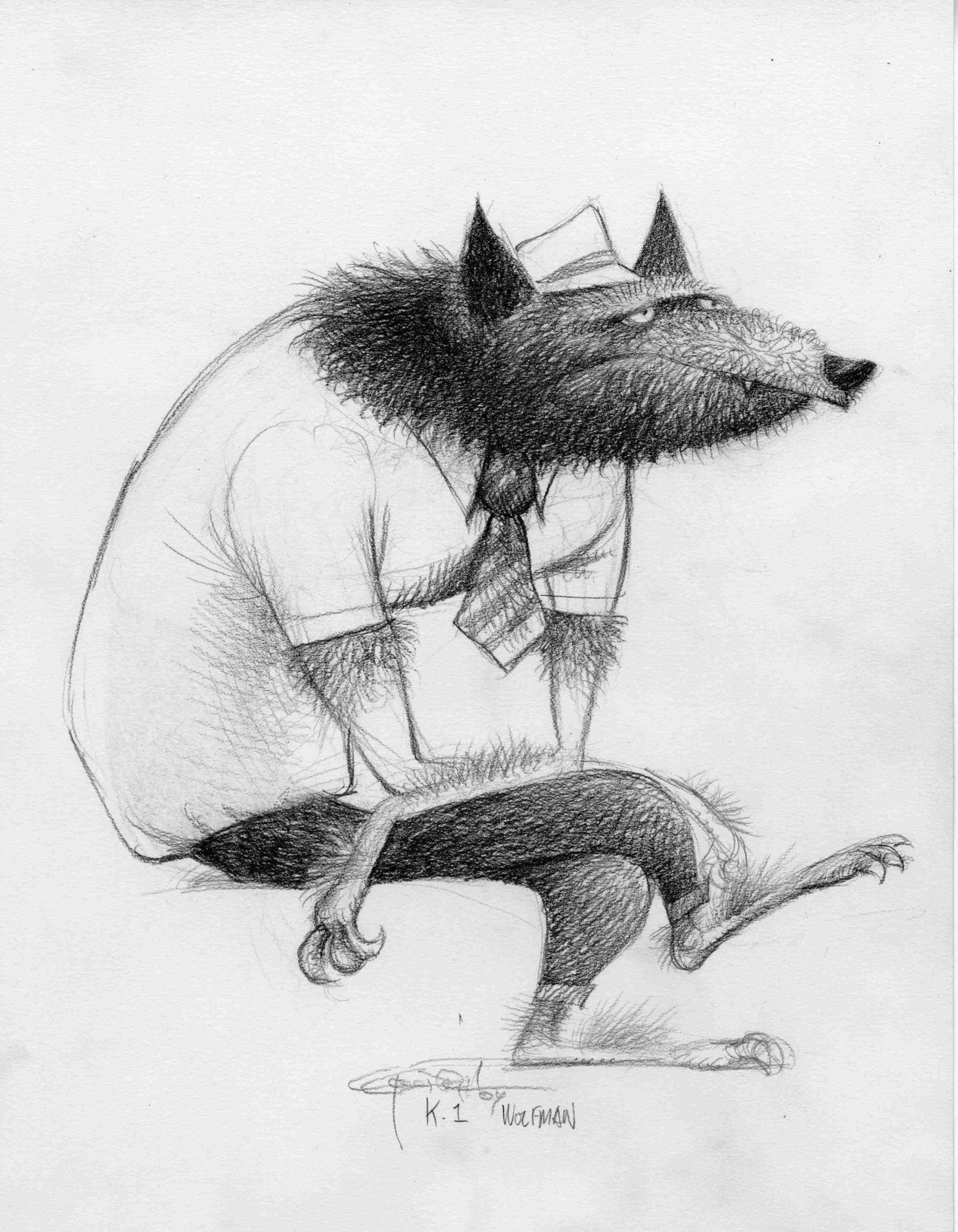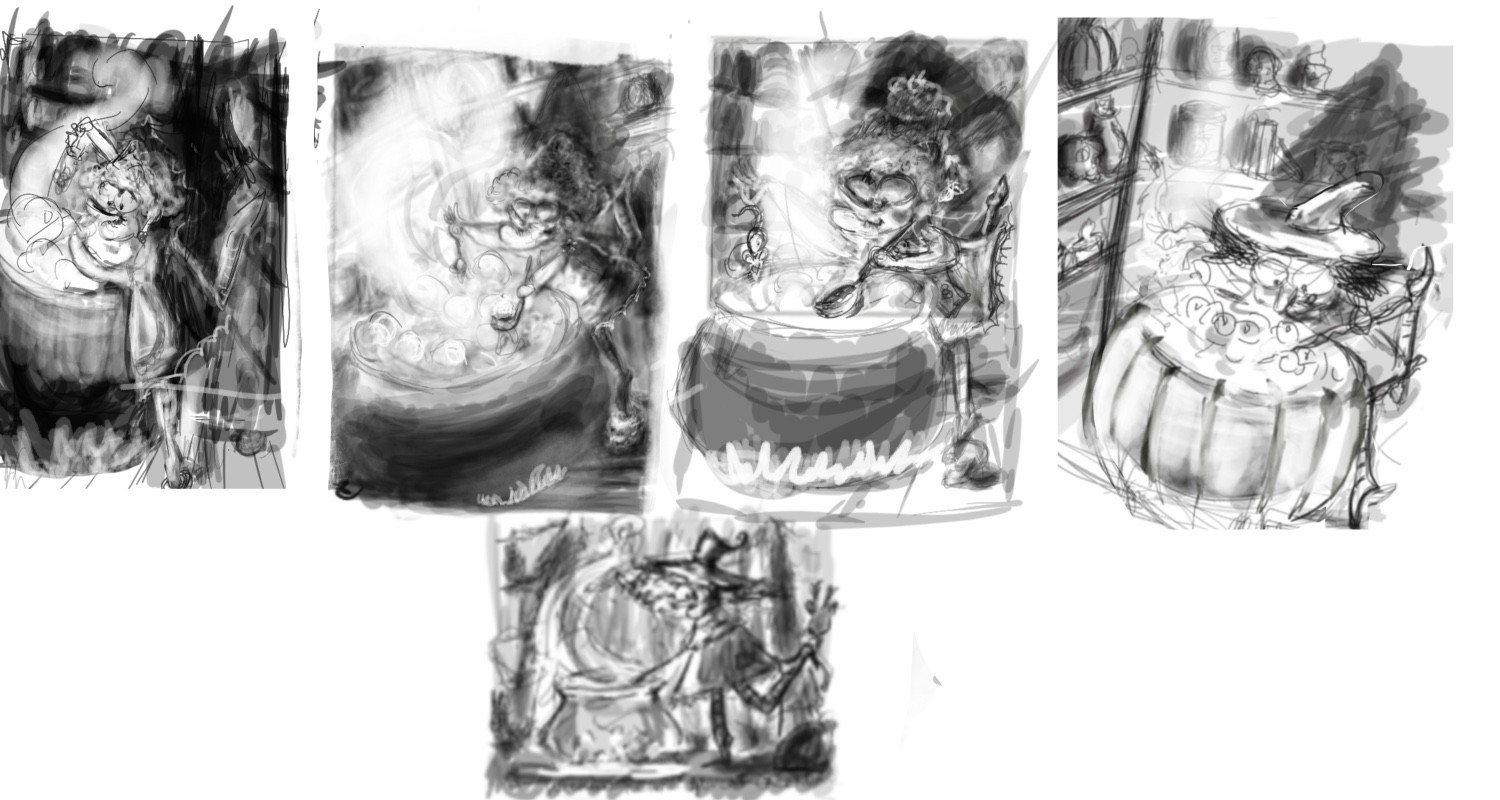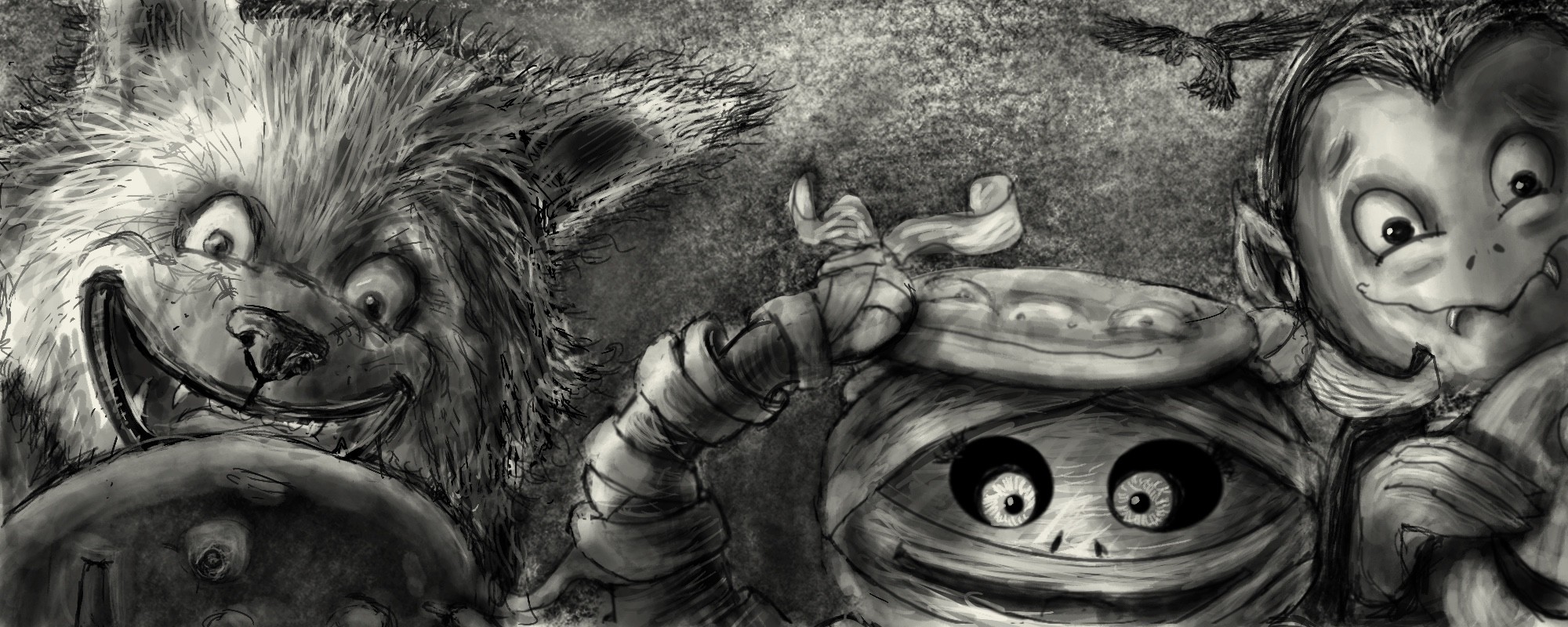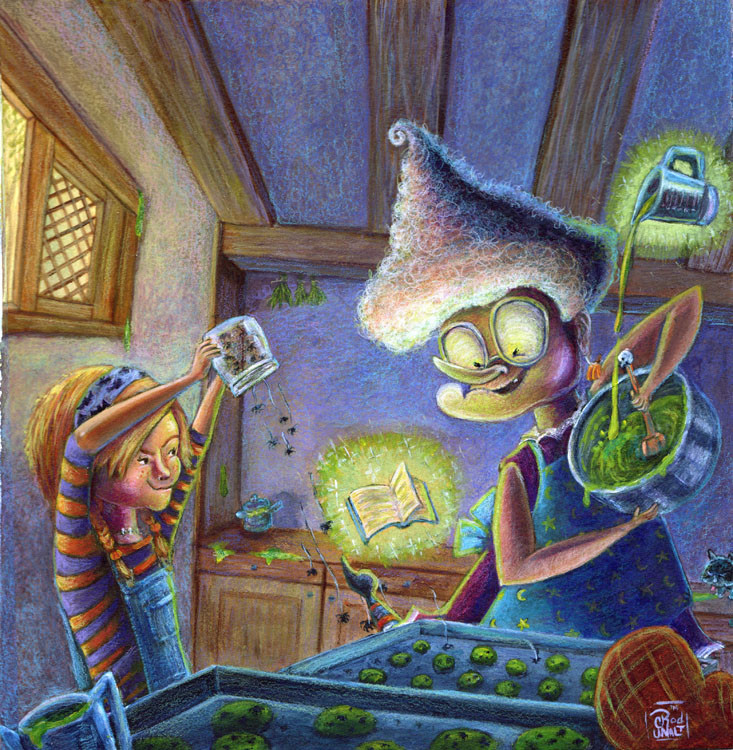
C. Rod. Unalt
Children's Illustrator
Who or what made you want to become an illustrator?
I always loved to draw pictures. In second grade, my art teacher had us do a project where we made our own scratch board. I made mine into a night sky with fireworks. She entered it into the Catholic Youth Organization where I won third place for my age group. It was the first time I had ever recieved gratification for something I created. Ever since then I was always looking up to my art teachers. I took lessons outside of school with a pastel and watercolor artist, Elaine Smith, who encouraged me to go to art school and helped me with my portfolio to get into art school. While in college, I gravitated towards the illustration department, Book Illustration, in particular. This class was instructed by Dennis Nolan, an award winning children's book artist who showed us how to make a book dummy from scratch. I refell in love with the magic of fairy tale characters and remembered reading storybooks as a child. It was in that class that I realized I was meant to be a children's book illustrator. I wanted the characters from my imagination to come to life.
Did you attend art school or undertake any other formal artistic training?
Yes. I am due to recieve my Masters in Illustration from University of Hartford this summer, where I also recieved my Bacholor's degree. Their MFA program is very unique in that it is low residency. We meet for two weeks of intensive workshops at the school for three consecutive summers and then travel in fall and spring to have workshops, lectures, and film and animation tour visits in different cities around the country. The rest of the work is done at home, while working on your thesis and staying in touch with the program coordinators. It is really a wonderful program.
Where do you currently live and where did you grow up?
I currently live in central New Jersey. I moved here from New York when I was ten.
Who or what have been some of your major artistic influences?
Oh, I have so many! I have always loved Disney concept art, especially the work that Mary Blair did for Sleeping Beauty. I also collect children's book and look at them constantly for inspiration. Scott Gustafson and Mary Jane Begin are amongst my favorites because of the way they draw their animal characters. Lately I have also taken a liking to the style of Mary Grandpre after seeing one of her Harry Potter exhibits in New York. I find her color palette so captivating. I also like to look at concept artists work such as Peter DeSeve and Carter Goodrich.

Carter Goodrich, 2012, ink, concept art for Hotel Transylvania
What was your first commission as a professional illustrator?
I actually had recieved my first job when I was asked to illustrate a bilingual book for Art Publico Press. While we were still working up the contract, I also recieved a call from Spider Magazine to illustrate a short story for two issues. They say when it rains, it pours!
Describe your working technique and how you came to perfect it.
I draw up at least twenty thumbnails to ensure I have come up with the best idea and perspective. I then take a thumbnail and blow it up so I can further refine it. After this, I gather reference. If I have trouble finding photographic reference or images from the Internet, I often sculpt my reference. If I build it, it stays within the parameters of my imagination. From there, I can light it and take photographical reference that will help me see lights and shadows for my developed character. Sculpting takes that extra step, but it has proven to be much more successful than just drawing from my head, because I can gather the correct lighting to work up a fully rendered drawing.
If I am unsure of where to put my color, I then create a digital color comp. I digitally overlay different color options on my sketch until I get something I think is sufficiently vibrant. Next, I print my sketch on hot press watercolor paper through my Epson Inkjet printer. I then fasten my paper with artist’s tape to a piece of foamboard. I start with my warm colors, working my way from yellow to orange to red, running them over the parts of my illustration that emulate warmth and my light source. I take blues and purples to push back my darks and shadows. I keep my paints watered down, so that I can still see my digital rendering underneath on the paper. When I am done with the under painting, I often find myself left with a character with a yellow and purple face.
After my under painting is dry, I start to use very light washes. I still use a lot of water for this stage, and mix it with my paint so that I can still see the vibrancy of my painting underneath. I try to work my illustration as far as I can before I use any white. I work up my painting to the point where it can pass as a finished piece. Lastly, I push my colors a bit more and can add a bit more texture with Prismacolor color pencils.

How many times do you tend to draw a character until you are happy with it?
Well I think that is different for every character. I keep drawing until I get it right. It might take ten sketches, it might take fifty.

C. Rod. Unalt

C. Rod. Unalt
Have you ever thought about trying out a different technique or a different style?
The way I currently work actually is a newer style for me. I used to work primarily in oil paint. While going through graduate school, I took an Experimental Illustration course that allowed me to work out of my comfort zone. I really liked the idea of working up a sketch digitally, pushing my values as far as I can go. Then printing out my sketch on watercolor paper, I begin to paint right on top of my sketch and finsih up with the colored pencils. I find this to be faster than painting in oils, and I can achieve a much more satisfactory look with vibrant colors without losing the gestural lines of my sketch.

How long does it take on average for you to finish a spread, from initial sketch to final colour?
I usually take a few days to work up a sketch. Of course, some are more complicated then others. If I decide to make sculpts to shoot for reference, this may take a few days longer. Then, I take about five days to complete the color.

What do you hope children take away from your drawings?
Wonder. I hope that it engages a question. "What is going to happen next?" "How will they get there?" If they want to know more, then the characters keep living on beyond the pages.

What would you say is a distinguishing feature of your artwork?
I would say my line work. I like to work on top of my sketch. You can still see some of the line work through the paint if you look at it closely. Then, the colored pencil lines compliment the sketch underneath. I love to draw and I love to paint. I think of my art as drawing with paint on top of a drawing.

Where do you get the ideas for your characters?
My family, mostly. I have a ten year old step daughter and a one a half year old son. They keep me on my toes and are a constant inspiration for characters and illustration concepts. I use them a lot for reference in my work.


C. Rod. Unalt
Which 4 words would you use to describe your illustration portfolio?
Vibrant. Whimsical. Magical. Animated.
Outline your dream project.
I would love to work on a Halloween book. Fall is my favorite season for its colors. I love the creativity and imagination that go into costumes and its a fun time for kids. As you can see I have more than a few Halloween inspired portfolio pieces. I even have my own book dummy that I am currenty shopping around for a publisher.

C. Rod. Unalt

C. Rod. Unalt
Have you taken part in any speaker events?
I have attended a few school visits with my books, mostly at local elementary schools. I also talked to a middle school and walked them through a drawing. I also was able to do two readings of my first book at my local Barnes and Noble, that was exciting!
Have you visited any schools to speak or hold workshops?
Yes, I have done multiple school visits and also own a painting party workshop. I teach people how to created a painting step by step in under three hours. I mostly get people that are unfamiliar with painting and curious. I find that they walk away with a new respect for the art industry. I try to make their painting class as easy and fun as possible, but it helps the public see that what we do is not so easy.
What advice would you offer someone just starting out as a children’s illustrator?
I would say do your research. Look at the trends in the current market and have a diverse portfolio in terms of scenary. Also, draw what you love! If you are having fun doing something that you create, then someone else may like it, too. You will get jobs based on what you have in your portfolio, so make sure you are showing pieces that you had fun doing. Show a combination of children and animals, children playing with other children, adults, landscapes, interiors and exteriors. The more you can show your ability to draw different settings, the better.

Do you have a favourite soundtrack you listen to when you’re working?
I'm a rocker! I like Tool, Nine Inch Nails, Rob Zombie, and Highly Suspect. It keeps me awake into the long hours of the night!
Are you an author/illustrator?
Right now I am published only as an illustrator, although I am shopping around a few concepts I have written myself and would love to illustrate my own books! It is at the top of my goal list.

What makes a good children’s book?
I find that a lot of books out there have a similar formula. Introduction of the character. Introduction of character's weakness and an obstacle they must overcome. Character makes three failed attempts to overcome obstacle. Character has a lightbulb moment that is directly related to their weakness and uses it to overcome obstacle. Conclusion of story, giving reader an emotion to walk away with.
I learned this formula in an SCBWI conference workshop and now see it in most books.
When you are not drawing, how do you like to relax?
Watching netflix! I also like to have a show on in the background while I work. If the show is good and bingeworthy, I keep working into all hours of the night.
What’s one thing that most people don’t know about you?
I started off as a scenic painter. I used to paint these large scale styrofoam sculptures. They were used for mini gold courses, parade floats, store window displays, and sometimes a Barmitzvah where you have to create large scale bobble heads of the New York Yankees players who were on the guest list!
How important is it for you to be part of a creative community of people?
I'm finding I am in need of this more and more. Going back to graduate school reignited that sense of community. My classmates and I became very close and encouraged each other to get through the program. We all live in different parts of the world, but communicate often. I am actively looking for a local writing group, as well. I am deadline oriented and need meetings to keep focused and stay on track.
If you weren’t an illustrator, what would you be doing?
Probably teaching. I have several students that take private art lessons with me. I love showing them things and watching them improve. Part of the reason I went back to graduate school was to get my MFA so that I can one day teach.
How do you overcome a creative block?
I suppose that being an illustrator, you really aren't able to have creative block. If its a particular subject I have to work on, I draw out fifty ideation drawings. I just keep drawing. Around number fifteen, you start coming up with an odd way of showing the same subject matter, whether it be on perspective or how you are figuring out the basic value structure. Keep pushing yourself, and then you'll find it.
If it is just coming up with an idea out of thin air, I find that stepping away and doing something completely unrelated usually helps. I'll be making a bowl of soup and then POOF, there it is!
What are some of your favourite subjects to draw?
Anything halloween! I love witches and monsters, pumpkins and the colors of fall leaves. I also love drawing elderly people as well as animals. I feel like I can really stretch their poses and animate their bodies to help tell my story.

C. Rod. Unalt
Animals feature heavily in children’s books – do you have a pet?
Does my husband and kids count?! Ha! Besides them I also have two cats who get into a lot of trouble. They are like a tag team duo. We've had them since they were a few weeks old and abandoned by their mother. We took them in and have had them for five years now. We also have a three year old beagle mix named Yogi. He is the best dog! He is so good with the kids and even snuggles with the cats. We also rescued him and couldn't have found a better companion for our family.
